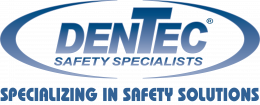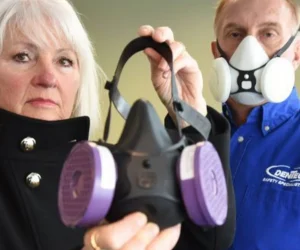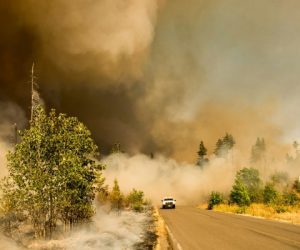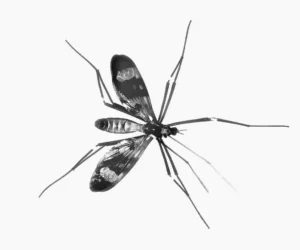Winter’s Coming and with colder weather comes different challenges and safety risks that Employers should be preparing for now to reduce risk of injury on the job. If you haven’t started to plan your winter safety problem, don’t worry Dentec’s got you covered with the top risks associated with colder weather and the steps you can take to reduce risks, keep employees safe and avoid costs associated with injuries.
Reduce Risk of Slips, Trips & Fall Injuries
According to Ontario Health & Safety, more than 40,000 workers get injured annually due to fall accidents in Canada. According to National Floor Safety Institute, slips and falls account for over 1 million hospital emergency room visits in the US every year. 85% of worker’s compensation claims are attributed to employees slipping on slick floors and surfaces (Industrial Safety & Occupational Health Markets 5th edition) and compensation and medical costs associated with employee slip/ fall accidents is approximately $70 billion annually! Falls occur in virtually all manufacturing and service sectors, but fatal falls however are most common in construction, mining, and certain maintenance activities.

There are some simple steps that employers can take anytime of the year to reduce the risk of falls however during the winter months when ice, snow and sleet are a common occurrence, ensuring workers are wearing safety footwear appropriate for the work being done to prevent slipping or falling on surfaces is key.
Traction Devices for employee footwear are a winter safety must have for all workers who are regularly coming in and out of buildings and vehicles. As a true Canadian Company, Dentec launched our NEW line of ICETRED™ Traction Devices to combat this very real risk for most Canadian businesses. Consider the magnitude of costs and losses that are created by injuries from accidental slips and falls. We all know that the expenses associated with injuries of this type extend far beyond medical treatment for both employee and company. Winter ICETRED™ Traction Devices offer a truly ECONOMICAL SOLUTION to a very real SAFETY concern. Winter ICETRED™ Traction Devices are lightweight and fit over the footwear people already own and feel comfortable in. This reduces fatigue caused by walking on icy surfaces or from using cumbersome traction aids and unfamiliar footwear.
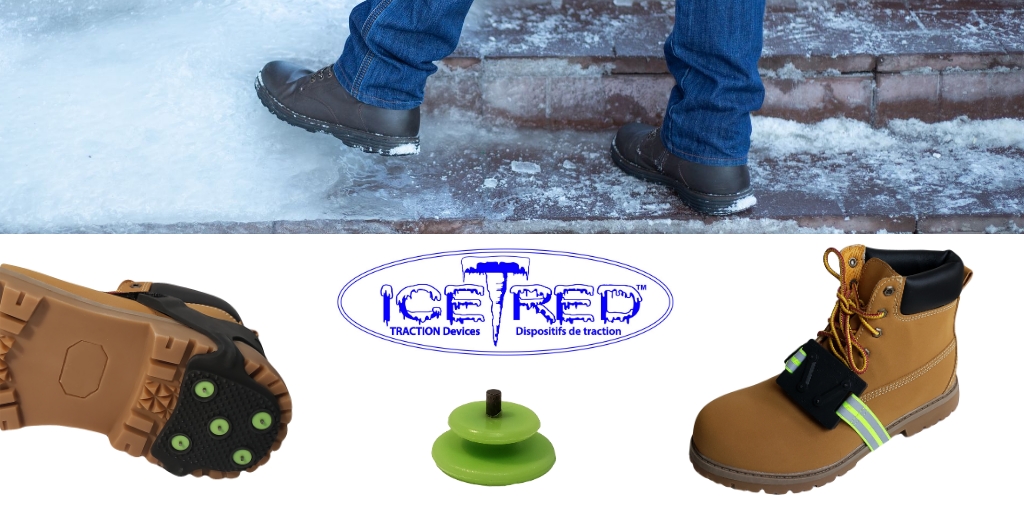
Available as Full Sole, Mid Sole and Heel Traction Devices, Dentec’s President Claudio Dente demonstrates how ICETRED devices work and grip to keep you and your employees from slipping on slick surfaces in this quick video:
Prevent slips, trip and falls all year round with these additional tips:
- All aisles and walkways should be kept free of clutter and debris.  
- Oil spills and other slippery materials should be cleaned up immediately.  
- Areas that are slippery because of the continuous use of water–common in the floriculture industry–should be off-limits as general traffic areas and restricted to those workers who must perform their duties in that area.
- Workers should put tools away when they are no longer needed.
- Sand and/or salt should be spread on icy surfaces if work has to be done in the vicinity. If the weather is particularly bad, consider putting the job off until conditions improve.
- Keep parking lots and walkways clear of snow and ice. Don’t get caught by surprise. Monitor the weather and expect slippery conditions.
- Clear ice and snow before workers need to get in or out of the parking lot.
- Provide good lighting and clear path markings in lots and walkways.
- Clearly identify steps, ramps, and other elevation changes.
- Clean up spills and wet areas inside immediately and mark the area.
- Secure mats and rugs that do not lay flat.
- Define everyone’s role in preventing slips and falls, and communicate those roles to all employees.
- Follow up and, if necessary, address slip, trip and fall concerns reported by employees.
Avoid Cold Weather Stress and Fatigue Injuries
Now that summer’s heat wave is behind us it’s not unusual for employers to move their Employee Hydration Program to low priority, but proper hydration is crucial to provide protection from cold weather stress and fatigue related injuries as well! Did you know that you can get dehydrated in winter just easily as the summer, if not more so? That’s because in cold weather you may not notice how much water you are losing. Dehydration is the leading cause of cold stress events and thirst is suppressed due to the body’s priority to keep core temperature from dropping. Large amounts of energy are used to keep the body warm (like shivering) and body heat is reserved for vital organs first. Also, increased urination/ sensation in cold temperatures contributes to an increase in fluid loss. Protect employees and keep them hydrated with Sqwincher working in the cold both indoors & outdoors. According to the Occupational Safety and Health Association’s (OSHA) recommendation for fluid intake when working in cold environments, they state:
“DRINK SWEET DRINKS AND/OR ELECTROLYTE REPLACEMENT DRINKS,

DO NOT DRINK COFFEE, TEA OR HOT CHOCOLATE”.
www.osha.gov/Publications/osha3156.pdf
The reason OSHA recommends that you should not drink tea, coffee or hot chocolate in cold temperatures is due to the fact that they contain caffeine. Caffeine causes “VASO CONSTRICTION” or a decrease of circulation to the extremities, such as hands, feet, nose and skin. As a result, this will increase the potential risk of frostbite, injuries caused by fatigue, decrease productivity and will reduce your body’s ability to maintain core body temperature.
Essential for worker safety:
- Electrolytes (magnesium, potassium, sodium and calcium) help maintain optimal nerve and muscle function.
- Electrolytes are lost through perspiration and other types of normal physiological body function.
- Electrolytes are proven to be absorbed into the body at a higher rate than plain water, allowing the body to replenish the electrolytes and minerals needed for rehydration.
- Palatability increases better hydration practices.
- Stay hydrated, fueled and focused with a proper electrolyte/hydration program.
The use of sweet drinks and/or electrolytes drinks in cold temperatures, as recommended by OSHA, will provide the following benefits:
- Increase hydration levels.
- Increase circulating volume, the amount of fluid in your body.
- Replenishes the electrolytes that provide the energy the muscles need to work more efficiently and enhance the hearts ability to pump blood to the extremities.
- Keep body core temperature at a more stable level allowing the body to stay warmer longer.
- Increase energy levels and endurance.
- DECREASES THE POSSIBILITY OF FROSTBITE.
- DECREASE THE POSSIBILITY OF INJURIES CAUSED BY FATIGUE.
- DECREASE THE POSSIBILITY OF COLD WEATHER ILLNESS SUCH AS COLDS, FLU, COUGHS, ETC.
- HELP TO REDUCE EMPLOYEE ABSENTEEISM.
- INCREASE PRODUCTIVITY.
When you give employee’s a beverage that’s easy to use and tastes good, they’re going to want to drink it an as a result, they’ll be more productive. Expressing interested in their safety and welfare boosts morale and being concerned about their electrolytes sends a constant, positive message to workers.
Although OSHA may not mandate a Cold Stress program it is their recommendation to provide SAFE PROCEDURES and METHODS to maintain safety and recognize hazards for all employees to prevent accidents and/or death.
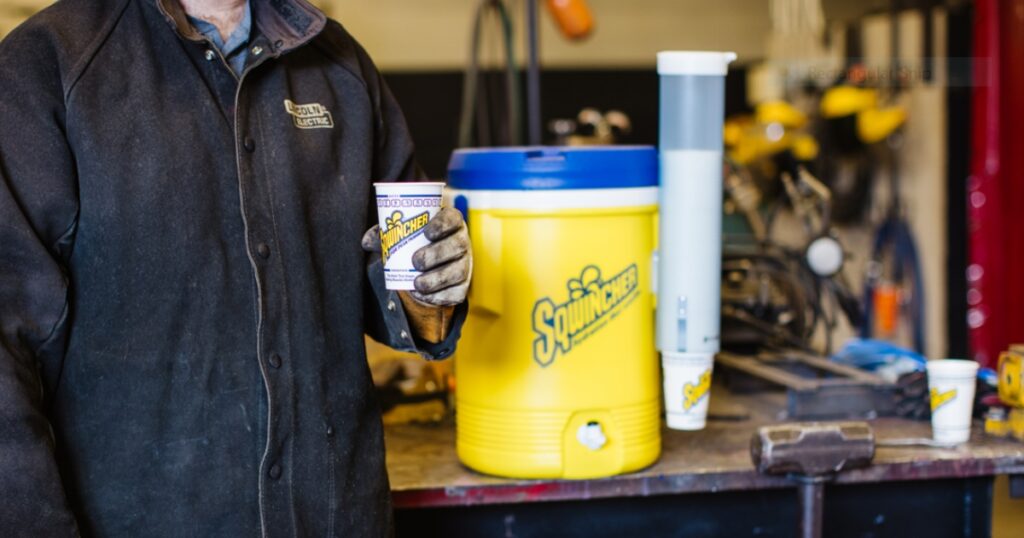
Hot Factory Operations During The Fall & Winter
In preparing for the hot summer months, customers with operations that require heat to manufacturer their products and plant operations that are hot and humid, implement an electrolyte replacement drink as part of a proper “Hydration program”. Examples of such operations are foundry, fabricating, pulp & paper mills, bakeries, aluminum and plastic extrusion operations to name a few. These manufacturing processes generate significant radiant heat that workers are required to work in. Those working in these operations are exposed to heat stress related injuries, injuries caused by fatigue and reduced productivity regardless of the time of year and the temperature outside.
Traditionally, these companies remove their electrolyte programs throughout the plant as soon as the summer ends or the outdoor temperatures cool. This practice exposes employees to heat stress related injuries, injuries caused by fatigue and reduced productivity. A more proper practice for these applications is to remove the Sqwincher electrolyte stations outside of the locations where high heat exists and allow continued use of Sqwincher for those working in or near the high heat areas, or what we call the “HOT ZONE”.
Make Sqwincher Part Of Your Health And Safety Program 12 Months Of The Year!
Keep Employees Warm Even in Harsh Outdoor Conditions

As much as we all would love to work in the comfort of a warm cozy office in those colder months, the reality is most businesses/ services in transportation, agriculture, construction and industrial settings require a majority of their employees to be working outdoors. Workers who are exposed to extreme cold or work in cold environments may be at risk to cold stress. According to NIOSH, Extreme cold weather is a dangerous situation that can bring on health emergencies in susceptible people, such as those without shelter, outdoor workers, and those who work in an area that is poorly insulated or without heat. Whenever temperatures drop decidedly below normal and as wind speed increases, heat can more rapidly leave your body. These weather-related conditions may lead to serious health problems.
| Disorder | Facts/Symptoms | Appropriate Response |
| Chilblains | Red, swollen, itchy skin due to inflamed blood vessels. Usually occurs on the face, ears, hands and feet. | Cover and protect areas immediately. Lotions and ointments can treat areas. For severe cases, consult a physician. |
| Trench Foot | Extended exposure to cold and wet conditions causing multiple symptoms including swelling, tingling, numbness and pain. | Go to a warm, dry place, remove wet clothing and gently dry feet. Warm the feet slowly and apply clean dry socks. DO NOT warm areas too quickly. Seek medical attention. |
| Frostbite | The freezing of skin and/or deeper tissue causing itching, burning, numbness and pain. Area will appear white to grayish in color and feel cold, waxy and hard. | Get out of the cold. Gradually warm affected areas with blankets and body-to-body contact. Do not apply direct heat or rub affected areas. This could cause further tissue damage, especially to affected areas below skin surface. Seek medical attention. |
| Hypothermia | Occurs when the body loses heat faster than it can produce heat and the core body temperature drops below 98.6°F. As the condition worsens, be aware of slurred speech, confusion, violent shivering, weak pulse, shortness of breath and loss of consciousness. Skin may have pale to blue appearance. | Get out of the cold immediately and call 911. Always handle the patient gently to keep from disturbing vital organs under low body temperatures. Remove any wet clothing and apply dry clothing when necessary. Apply any warming to the neck, chest and groin first. Do not warm extremities first due to threat of shock. Get victim to the nearest hospital immediately. A body temperature of 82°F or below results in death. |
Wearing the appropriate clothing is the first step to prepare against cold stress but incorporating protective thermal apparel into your safety program can greatly reduce the chance of cold stress injury.

Consider implementing protect apparel like Thermo-Heat- cold weather products that protect your head and neck in extreme environments. And don’t forget providing warmers that can be inserted into your Thermo Heat Winter liners, work gloves and safety shoes for added warmth. Dentec’s HOTTEC® warmers are air activated and made with all natural ingredients. Simply remove them from their package, shake for approximately 30 seconds and feel the heat. The warmers have a three-year shelf life, twice as long as most competitive products.

Stay safe and protect against Cold Stress with these simple NIOSH tips:
- Wear several layers of loose clothing. Layering provides better insulation.
- Tight clothing reduces blood circulation. Warm blood needs to be circulated to the extremities.
- When choosing clothing, be aware that some clothing may restrict movement resulting in a hazardous situation.
- Make sure to protect the ears, face, hands and feet in extremely cold weather.
- Boots should be waterproof and insulated.
- Wear a hat; it will keep your whole body warmer. (Hats reduce the amount of body heat that escapes from your head.)
- Move into warm locations during work breaks; limit the amount of time outside on extremely cold days.
- Carry cold weather gear, such as extra socks, gloves, hats, jacket, blankets, a change of clothes and a thermos of hot liquid.
- Include a thermometer and chemical hot packs in your first aid kit.
- Avoid touching cold metal surfaces with bare skin.
- Monitor your physical condition and that of your coworkers.
To learn more about how to protect against cold stress and winter injuries check out our wide range of products and solutions here.
Dentec Safety is a leading manufacturer and distributor of safety products in the North America since 2004. Dentec Safety is dedicated to providing the highest quality safety products and solutions delivering enhanced value and comfort. Our expertise from decades of experience in Industrial Safety and our innovative design technologies have solidified us as thought leaders in the field. Protection and comfort are at the core of everything we do at Dentec. As a leading manufacturer of Safety Solutions, it is our mission to help organizations do the right thing, keep their employees safe and exceed Industry Health & Safety Standard.
